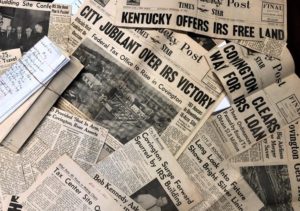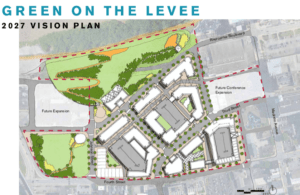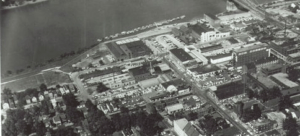This Guest Article for REVITALIZATION is written by Tom West, AICP.
Almost 60 years old, the newspaper clippings are faded and fragile.
But with the rapid-fire publication of daily journalism, their headlines reveal the fascinating story of Covington’s concerted – some would say “desperate” – efforts in the early 1960s to land a massive IRS data processing facility.
Collectively they describe a solid plot for a documentary, if not a low-budget spy movie, that even today tantalizes with intrigue and drama:
The almost accidental discovery by Covington officials of the federal government’s search … a bus tour of 12 separate potential sites in Northern Kentucky … a verbal deal with President Kennedy and conversations with his brother, the U.S. Attorney General … flights to Washington … lively negotiations with more than 160 property owners whose parcels would comprise the final 17-acre site … lawsuits … protests … the remake of a 1930-era development plan into a modern Urban Renewal Plan … a $1.8 million federal loan … a $2.5 million revenue bond issue … other states’ attempts to sabotage the deal, and their outrage when they lost … an 88-year-old Congressman whose influence still opened doors … the late engagement of a U.S. Senator whose bust is now displayed near the entrance to Kentucky’s Capitol Rotunda … and, through it all, the offer that nailed down Covington’s lid of success – the agreement to sell the site to the federal government for a whopping $1.
Why so low?
Partly it was the desperate need to bring thousands of jobs to a City that a few years later would be singled out by the same federal government as one of the “most distressed” cities in America, current Covington Manager David Johnston says. And partly it was an effort to beat back attempts by the cities of Detroit, Cincinnati and others to snake away the development even after site preparation was well under way.
“The $1 offer was what Covington used as leverage amid the political intrigue,” Johnston said. “The beneficiary was the federal government.”
The matter had seemed settled on Jan. 24, 1962, judging from the bold-font, all-capped banner headline in The Kentucky Post and TIMES-STAR that read, “CITY JUBILANT OVER IRS VICTORY: Federal Tax Office to Rise in Covington.”
On the weight of that announcement, Covington began to assemble the pieces of the site a few months later, buying the first of 161 properties on June 26 of that year with borrowed money. Demolition started Aug. 10, 1962, with Kentucky Lt. Gov. Wilson Wyatt in attendance.
Meanwhile, the Covington City Commission issued $2.5 million in revenue bonds to demolish the many houses and businesses, rip out roads, and reroute water and sewer lines.
Then came word in early 1963 that – despite Covington’s preparations – federal officials representing Cincinnati and Detroit were putting heavy pressure on IRS officials in hopes of changing their minds.
(Ohio officials had never gotten over the 1962 announcement, angrily calling Kentucky’s coup “a display of power politics and a direct slap” and “cause for rejoicing among the unemployed stick men and blackjack dealers in northern Kentucky,” according to a Cincinnati newspaper article.)
Beating back those attempts required trips to Washington, stern lobbying from the aging Congressman Brent Spence of Fort Thomas, and the engagement of U.S. Sen. John Sherman Cooper – an international statesman who, although a Republican, was a former colleague and respected friend of President Kennedy (and was later picked to help investigate his assassination).
With strong advocates working on Covington’s behalf, the President and the General Services Administration (GSA), the agency that serves as the federal government’s landlord, again made it clear that the data center would land in Covington.
As part of the deal, the City agreed to convey the site to the federal government for $1. For purposes of the urban renewal project, the fair market value of the site had been set at $1,325,287, but the City had borrowed a total of $4.3 million to pay the costs of assembling the properties and preparing the site for use by the IRS. (In selling the property for public use, the City also surrendered the right to reap property tax revenue for many decades on what would eventually grow to 23 acres.)
It took two years of legal work and City Commission action to solidify arrangements.
But at 7:30 a.m. on June 7, 1965, in the drizzling rain, the Post and TIMES-STAR’s Frank Altizer snapped a photograph of bulldozer operator Clyde Showalter as the blade of a 19-ton Caterpillar D7 knocked down the first of 63 trees.
“It’s Covington’s Big Day! Work Starts on IRS Plant” read The Post’s two-line headline.
The data processing center would open May 15, 1967, to great fanfare and praise, in one columnist’s mind triggering Covington’s “abrupt ascension.”
It didn’t take long for the IRS to become Covington’s largest employer and a major source of the payroll tax revenue that funded half of the City’s General Fund.
Current negotiations
 After a laborious search, the historic newspaper clippings were discovered earlier this year in a large manila envelope in the basement of City Hall, along with other documents detailing the City’s efforts, including hand-typed copies of bond agreements, ordinances, resolutions, and a 1965 warranty deed.
After a laborious search, the historic newspaper clippings were discovered earlier this year in a large manila envelope in the basement of City Hall, along with other documents detailing the City’s efforts, including hand-typed copies of bond agreements, ordinances, resolutions, and a 1965 warranty deed.
Covington leaders have long considered the documents important context in modern-day leaders’ efforts to get the land back from the federal government with the closing of the IRS complex last fall.
“All this history demonstrates that City leaders at the time were very aggressive in pursuing this center, even to the point of basically giving the land to the federal government,” Johnston said. “At the same time, this history provides important evidence that we hoped would have influenced recent purchase negotiations.”
After giving notice of its plans in 2016, the IRS shut down Covington’s paper-processing facility on Sept. 28, 2019, as part of ongoing adaptation to the increasingly digital nature of tax filing.
At its peak, the sprawling IRS “Flat Top” had employed 4,000 full-time and seasonal workers. The closing removed $1.5 million a year in payroll tax revenue from the City’s General Fund, money that is used to fund services.
Almost a year before the closing, the City hired Cooper Carry, an Atlanta-based architecture and design firm, to create a conceptual design for the site, for which it engaged the public on dozens of occasions over a year, and to help secure the property from the federal government.
Negotiations between the City and the GSA started Dec. 9, 2019, and lasted for months. In one counter-offer, Johnston recalled City leaders’ work almost 60 years ago: “Since the City undertook all of the work and cost to assemble the properties needed for the IRS processing center in the early 1960s to meet the space requirement of the U.S. Government to fulfill its mission, we feel it is fair to request the U.S. Government re-convey the property to the City for the same price the property was acquired by the U.S. Government.”
Just as it had almost 60 years ago, the City agreed to absorb all the significant costs of demolition, road changes, and utility work. It also emphasized that the conceptual plan set aside much of the property for public use, including a public plaza, wide sidewalks, and a levee park.
But the City’s $1 turnabout offer was rejected.
“We were told that federal law requires the GSA to get as much as it can for properties, even when it’s a local government buying it,” Johnston said.
With that in mind – and with the sudden revelation from both the GSA and Congressional staff that another local government in Northern Kentucky had conveyed its interest in buying the property at the GSA’s appraised value – the City capitulated.
The Covington Board of Commissioners in mid-March authorized Johnston to offer the GSA the full asking price of $21.8 million for the site. But with some quick negotiation, the City was able to get that price reduced to $20.5 million, and the Commission then formally voted to direct Mayor Joe Meyer to accept the negotiated sales price. The City promptly paid 10 percent of that price in “earnest money.”
“We had spent over a year with a consultant engaging the public and had created an exciting vision for the site that best served the needs of Covington and its taxpayers,” Mayor Meyer said.
“After all that preparation and cost, we couldn’t afford to let the property slip away and risk that investment of time and money being tossed aside,” he said. “This site is very significant to Covington on a number of levels, and it’s critical that it be developed in a cohesive way that ties the surrounding attractions together, reconnects us to the river, and above all creates tax revenue to support City services, just like the IRS did.”
What’s next
 The City is still working to get “credit” for the planned public use of much of the site, and it will spend the next few months securing the title to the site and planning the long and expensive process of physically preparing it for the market. Site preparation – including demolition, reestablishing a street and sidewalk grid, and running utility infrastructure – could take up to three years.
The City is still working to get “credit” for the planned public use of much of the site, and it will spend the next few months securing the title to the site and planning the long and expensive process of physically preparing it for the market. Site preparation – including demolition, reestablishing a street and sidewalk grid, and running utility infrastructure – could take up to three years.
Cooper Carry’s “vision” includes a restored street grid, a levee park, a community plaza for festivals, and a mixture of buildings containing offices, retail shops, and places to live.
Top priorities are jobs, a return on investment for taxpayers, a mixture of uses, and connections to the Ohio River and integration with surrounding neighborhoods and business centers.
The City is eager to develop the property, Mayor Meyer said.
“We’re excited about the work ahead,” he said. “Covington has a lot of economic momentum right now, and we see this site as a continuation of that progress. When future generations look at Covington, these 23 acres will be part of the fundamental fabric of the city’s economy and daily life.”
About the Author:
 Tom West, AICP is the City of Covington’s Economic Development Director. He joined the City of Covington in December 2017 as Economic Development Director. His department is responsible for business attraction, retention and expansion programs as well as administering the City’s zoning code and historic preservation guidelines.
Tom West, AICP is the City of Covington’s Economic Development Director. He joined the City of Covington in December 2017 as Economic Development Director. His department is responsible for business attraction, retention and expansion programs as well as administering the City’s zoning code and historic preservation guidelines.
Previously, Tom was Senior Vice President of a national economic development and workforce consulting firm with clients from Oregon to the Carolinas. He also served as Executive Director of Governor Steve Beshear’s Workforce Investment Board for five years. He has three decades of experience in downtown revitalization and workforce development as a practitioner or consultant. Tom earned a bachelor’s degree in mass communications and a Masters in community planning. He also holds a certification from the American Institute of Certified Planners.


